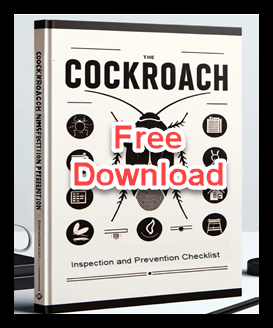Do Spiders Eat Cockroaches?
 Unveiling Nature’s Pest Control
Unveiling Nature’s Pest Control
Welcome to the fascinating intersection of fear and curiosity—where the dread of cockroach infestations meets the enigmatic world of spiders. It’s a common scene in households worldwide: a sudden scurry of a cockroach vanishing into the shadows, leaving behind a trail of unease. Equally common, though less unsettling, is the sight of a spider, silently perched in its web or corner. This juxtaposition raises an intriguing question that has puzzled homeowners and nature enthusiasts alike: Do spiders eat cockroaches?
The answer weaves into the broader narrative of natural pest control, a topic gaining traction among those seeking eco-friendly alternatives to chemical repellents. Spiders, with their diverse diet and hunting strategies, emerge as potential allies in our ongoing battle against cockroaches. But how effective are these eight-legged arachnids in keeping cockroach populations at bay? And can understanding their dietary habits offer us insights into a more harmonious coexistence with the natural world?
Join us as we delve into the heart of this query, exploring the dietary preferences of spiders, identifying the species most likely to prey on cockroaches, and evaluating the practicality of relying on these arachnids as a form of pest control. Whether you’re grappling with a pest problem or simply fascinated by the intricate dance of predator and prey, this exploration sheds light on the unseen dynamics that play out in the corners of our homes and gardens.
The Diet of Spiders
Spiders are one of nature’s most efficient predators, not just because of their fascinating hunting methods, but also due to their varied diet that helps control the population of many insect species. But what exactly do these eight-legged hunters feast on?
A Diverse Palette
The diet of a spider is as diverse as the species itself. With over 45,000 species of spiders cataloged across the globe, their dietary habits can range from the highly specialized to the opportunistic. However, the core of a spider’s diet is made up of insects and other arthropods. This includes flies, mosquitoes, moths, beetles, and yes, even cockroaches.
Hunting Strategies
Spiders employ a variety of hunting strategies that are as diverse as their diet. Some, like the orb-weaver spiders, construct intricate webs to trap unsuspecting prey that flies into their sticky strands. Others, such as the wolf spider, forgo web-building altogether, opting instead for a more direct approach by hunting their prey on the ground.
Cannibalism and Beyond
Interestingly, spiders’ diets are not limited to insects alone. Cannibalism is not uncommon among spiders, especially when food is scarce or in densely populated areas. Some larger species may even prey on small mammals, birds, and fish, highlighting the adaptability and voracious appetite of these arachnids.
The Role of Spiders in Pest Control
Given their broad diet, spiders play a crucial role in controlling the populations of various pests, including those that are detrimental to human habitation and agriculture. Their presence in and around homes can significantly reduce the number of unwanted insects, including cockroach juveniles and adults, depending on the size and species of the spider.
Spiders That Prey on Cockroaches
While the idea of using spiders as a form of natural pest control against cockroaches might seem appealing, it’s essential to understand which spiders are up to the task. Not all spiders are interested in or capable of preying on cockroaches, but there are a few notable exceptions that do make these pests part of their diet.
Huntsman Spiders
Huntsman spiders are among the most effective predators of cockroaches. Known for their impressive size and speed, these spiders are capable hunters that can easily overpower a cockroach. Their preference for warm climates often brings them into close proximity with human dwellings, where they can be found hunting at night. Despite their somewhat intimidating appearance, huntsman spiders are generally harmless to humans and can significantly reduce cockroach populations.
Wolf Spiders
Wolf spiders, with their robust bodies and excellent hunting skills, are also known to feast on cockroaches. Unlike web-spinning spiders, wolf spiders chase down their prey, using their speed and agility to catch cockroaches on the ground. These spiders are solitary hunters and can often be seen roaming the floors and walls of homes in search of their next meal. Welcoming a wolf spider into your home means enlisting a tireless pest controller that works around the clock.
House Spiders
Common house spiders, while smaller than huntsman and wolf spiders, can also contribute to controlling cockroach populations. These spiders tend to build their webs in corners, under furniture, and in other out-of-the-way places where cockroaches might venture. While they may not take down adult cockroaches, house spiders can help manage juvenile cockroach populations, reducing future infestations.
The Natural Balance
It’s important to note that while these spiders can help control cockroach populations, they are not a silver bullet solution to a cockroach infestation. However, their presence in our homes is a testament to the delicate balance of nature’s ecosystem, where each species plays a role in controlling the populations of others. Encouraging the presence of these natural predators can be a part of an integrated pest management strategy that seeks to reduce reliance on chemical pesticides and promote biodiversity.
Effectiveness of Spiders in Controlling Cockroach Populations
While the idea of harnessing spiders as natural pest controllers is appealing, it’s crucial to assess the effectiveness of such an approach realistically. Spiders, indeed, prey on cockroaches, but several factors influence their impact on cockroach populations in our homes.
Factors Influencing Effectiveness
- Species and Size: The effectiveness of a spider in controlling cockroaches largely depends on its species and size. Larger spiders, such as huntsman spiders, are more capable of preying on adult cockroaches, while smaller spiders may only manage to catch smaller, juvenile cockroaches.
- Habitat and Hunting Grounds: The natural habitat and preferred hunting grounds of the spider also play a significant role. Spiders that hunt on the ground, like wolf spiders, are more likely to encounter and prey on cockroaches than those that dwell in webs placed in less frequented locations.
- Population Density: The impact of spiders on cockroach populations is also contingent upon their density in a given area. A solitary spider can only consume so many cockroaches, and unless there is a significant number of predatory spiders, their effect on an established cockroach infestation might be minimal.
The Reality of Pest Control
Spiders can contribute to controlling cockroach populations, but they are unlikely to eradicate an infestation entirely. Cockroaches are known for their resilience and rapid reproduction rates, which can outpace the predation pressure exerted by spiders. Additionally, the presence of spiders in significant numbers inside a home may not be desirable for everyone.
Integrating Spiders into Pest Control Strategies
Acknowledging the limitations of relying solely on spiders for cockroach control, it’s wise to view them as part of an integrated pest management (IPM) strategy. This approach combines physical, biological, and chemical methods to manage pest populations effectively and sustainably. Encouraging the presence of spiders can be one aspect of this strategy, complemented by:
- Sealing entry points to prevent cockroach access.
- Maintaining cleanliness to eliminate food sources.
- Using traps or baits to manage cockroach numbers.
Conclusion
While spiders are valuable allies in the fight against cockroaches, their effectiveness as standalone pest controllers is limited. Recognizing their role in the broader ecosystem and integrating them into a comprehensive pest management strategy can help manage cockroach populations more effectively, leading to a healthier home environment.
Benefits and Limitations of Using Spiders for Cockroach Control
Benefits
Natural Pest Control: Spiders are nature’s pest controllers. Their presence in and around homes can significantly reduce the populations of various household pests, including cockroaches, by naturally keeping their numbers in check.
Eco-Friendly: Utilizing spiders as part of pest control strategies minimizes the need for chemical pesticides, which can have harmful effects on the environment and human health. Spiders offer a more sustainable and environmentally friendly alternative.
Cost-Effective: Encouraging spiders to thrive in natural habitats around your home does not incur any costs, making it a cost-effective method for reducing pest populations.
Biodiversity: Spiders contribute to biodiversity, both as predators and as prey for other species. Their presence in an ecosystem is a sign of environmental health.
Limitations
Selective Predation: Spiders do not exclusively prey on cockroaches and will feed on a wide range of insects. Their presence alone may not sufficiently control cockroach populations, especially in the case of a severe infestation.
Fear and Misunderstanding: Many people have arachnophobia or a general unease around spiders. The idea of encouraging spiders as a form of pest control may not be appealing to everyone.
Indoor vs. Outdoor Effectiveness: While some spiders can thrive indoors and help control pests, many species are more effective in outdoor environments. The effectiveness of spiders in controlling indoor cockroach populations can vary.
Not a Standalone Solution: Relying solely on spiders for cockroach control is unlikely to be effective in eliminating an infestation. Integrated pest management approaches are necessary for comprehensive pest control.
Balancing the Benefits and Limitations
Understanding the benefits and limitations of using spiders as a form of natural pest control is crucial. While they play a significant role in managing pest populations, including cockroaches, spiders should be considered part of a broader, integrated pest management (IPM) strategy. This strategy might include maintaining cleanliness, sealing entry points, and, if necessary, using chemical controls judiciously.
Encouraging the presence of spiders around your home can be beneficial, but it’s essential to complement their natural predation with other pest control measures to effectively manage cockroach populations and ensure a comfortable living environment for all occupants.
Safe Pest Control Practices
Do spiders eat cockroaches? Yes, but while spiders play a natural role in controlling cockroach populations, relying solely on these arachnids isn’t enough to keep your home pest-free. Combining the benefits of spiders with other safe pest control practices can create a more effective and holistic approach. Here are some eco-friendly and safe strategies to manage and prevent cockroach infestations:
Maintain Cleanliness
- Eliminate Food Sources: Store food in sealed containers and avoid leaving dishes in the sink overnight. Regularly clean crumbs and spills from countertops, floors, and under appliances.
- Reduce Clutter: Clutter provides hiding spots for cockroaches. Regularly declutter your home, focusing on areas like basements, attics, and closets.
Seal Entry Points
- Cracks and Gaps: Inspect your home for cracks in walls, gaps around windows and doors, and holes where pipes enter. Use caulk or weatherstripping to seal these entry points.
- Ventilation: Ensure that vents are properly screened to prevent cockroach entry while maintaining good air circulation.
Use Natural Repellents
- Diatomaceous Earth: A non-toxic powder that can be sprinkled in areas where cockroaches are likely to enter or hide.
- Essential Oils: Some essential oils, like peppermint and lemongrass, have been reported to repel cockroaches. Use them in a diluted form as a spray around entry points and problem areas.
Encourage Natural Predators
- Outdoor Habitat: Create an outdoor environment that encourages spiders and other natural predators by maintaining a garden with a diversity of plants and minimizing the use of pesticides.
- Indoor Spiders: If you’re comfortable, allow non-venomous spiders to reside in less-frequented areas of your home, like basements and garages, where they can catch pests.
Professional Help
- Severe Infestations: For significant cockroach problems that persist despite your efforts, consider consulting a professional pest control service that uses eco-friendly methods.
Integrated Pest Management (IPM)
Adopting an IPM approach means using a combination of biological, cultural, physical, and chemical management tools in a way that minimizes economic, health, and environmental risks. Spiders are a part of this biological toolkit, working alongside your efforts to create a balanced, pest-resistant home environment.
Conclusion
Do spiders eat cockroaches? The intricate dance between predators and prey in our homes and gardens highlights nature’s delicate balance. Spiders, with their diverse diets and hunting strategies, play a crucial role in this ecosystem, including the control of pests like cockroaches. While the thought of using spiders as a natural form of pest control is intriguing, it’s clear that their effectiveness is influenced by various factors, including species, habitat, and the size of the pest population.
Understanding the benefits and limitations of relying on spiders for cockroach control is key. They can be valuable allies in reducing pest numbers, but they are not a standalone solution to infestations. Integrating spiders into a broader pest management strategy that includes cleanliness, sealing entry points, using natural repellents, and, when necessary, seeking professional help, offers a more comprehensive approach to keeping our homes pest-free.
Encouraging the presence of spiders and adopting safe pest control practices not only minimizes our reliance on chemical treatments but also supports biodiversity and ecological health. As we navigate the challenges of pest management, let’s remember the role of natural predators and the importance of creating balanced environments that benefit both humans and the planet.
In the end, the question “Do spiders eat cockroaches?” opens the door to a deeper understanding of nature’s complexities and the opportunities for sustainable living within our own homes. By embracing eco-friendly pest control methods and recognizing the value of all creatures in the ecosystem, we can foster healthier, more harmonious spaces for ourselves and future generations.
- The Life Span of a Cockroach
- Do Cockroaches Eat Clothes?
- Do Cockroaches Have Teeth?
- Shrimps and Cockroaches
- Will Sleeping with the Light On Keep Cockroaches Away?
- How to get roaches out of your car overnight
- Do Cockroaches Feel Pain?
- How Many Legs Do Cockroaches Have?
- Comparing Cockroach Eggs Size for Different Types of Cockroaches
- Identifying a Cockroach Bite on the Lips or Face
- Black Water Bug Identification and Control
- Why Do Water Bugs Come Out At Night?
- What Does Roach Rash Look Like?
- Can Cockroaches Bite Your Eyelid?
- Can Cockroaches Live in Your Balls?
- How did cockroaches get their name?
- Why Do Cockroaches Shed Their Skin?
- What Smell do Palmetto Bugs Hate?
- Baby Palmetto Bug: Identification and Control
- Cockroach Eggs vs Poop: How to Tell the Difference
- How to Get Rid of Water Bugs
- How Long Can a Cockroach Live Without Air?
- The Lifecycle of the German Cockroach: From Egg to Adult
- Do Mice Eat Roaches
- Wood Roach vs. Cockroach

